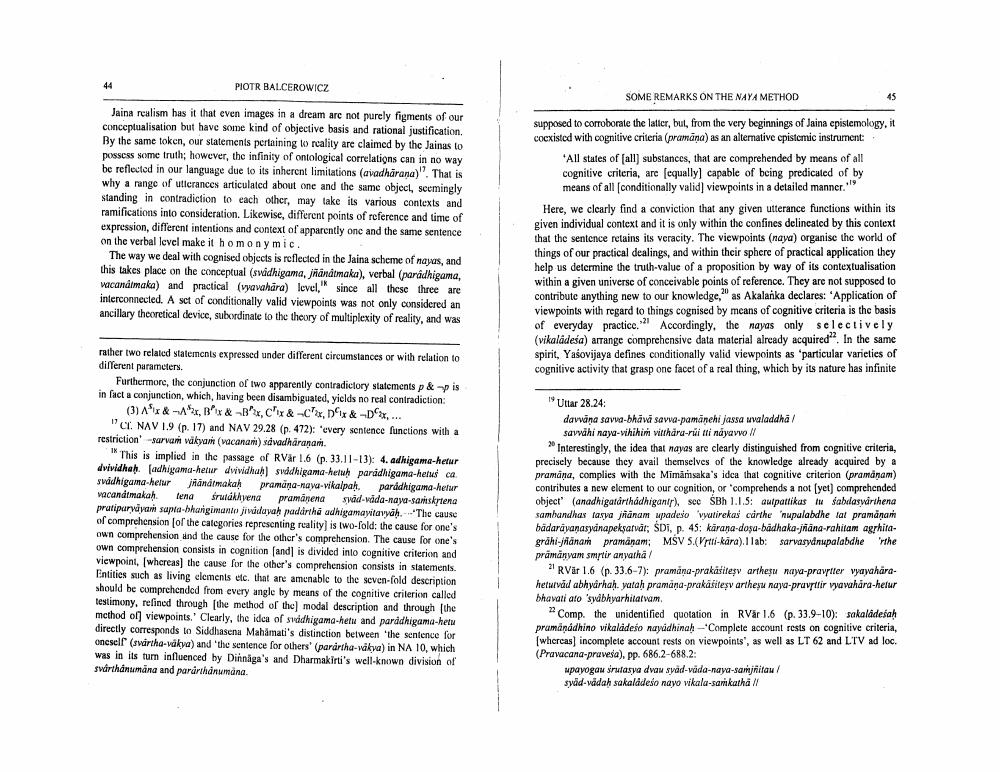Book Title: Some Remarks On The Naya Mmethod Author(s): Piotr Balcerowicz Publisher: Piotr Balcerowicz View full book textPage 5
________________ PIOTR BALCEROWICZ SOME REMARKS ON THE NAYA METHOD Jaina realism has it that even images in a dream are not purely figments of our conceptualisation but have some kind of objective basis and rational justification. By the same token, our statements pertaining to reality are claimed by the Jainas to possess some truth; however, the infinity of ontological correlations can in no way be reflected in our language due to its inherent limitations (avadharana)". That is why a range of utlerances articulated about one and the same object, seemingly standing in contradiction to each other, may take its various contexts and ramifications into consideration. Likewise, different points of reference and time of expression, different intentions and context of apparently one and the same sentence on the verbal level make it homonymic. The way we deal with cognised objects is reflected in the Jaina scheme of nayas, and this takes place on the conceptual (svadhigama, jñanaomaka), verbal (paradhigama, wacana maka) and practical (vyavahara) level, since all these three are interconnected. A set of conditionally valid viewpoints was not only considered an ancillary theoretical device, subordinate to the theory of multiplexity of reality, and was supposed to corroborate the latter, but, from the very beginnings of Jaina epistemology, it coexisted with cognitive criteria (pramana) as an alternative epistemic instrument *All states of (all) substances, that are comprehended by means of all cognitive criteria, are equally] capable of being predicated of by means of all conditionally valid] viewpoints in a detailed manner." Here, we clearly find a conviction that any given utterance functions within its given individual context and it is only within the confines delineated by this context that the sentence retains its veracity. The viewpoints (naya) organise the world of things of our practical dealings, and within their sphere of practical application they help us determine the truth-value of a proposition by way of its contextualisation within a given universe of conceivable points of reference. They are not supposed to contribute anything new to our knowledge, as Akalahka declares: 'Application of viewpoints with regard to things cognised by means of cognitive criteria is the basis of everyday practice. Accordingly, the nayas only selectively (vikaladesa) arrange comprehensive data material already acquired". In the same spirit, Yasovijaya defines conditionally valid viewpoints as particular varieties of cognitive activity that grasp one facet of a real thing, which by its nature has infinite programa ada rather two related statements expressed under different circumstances or with relation to different parameters. Furthermore, the conjunction of two apparently contradictory statements p& is in fact a conjunction, which, having been disambiguated, yields no real contradiction: (3) Afr&-A2, B & B'C'x&-CP,DU&-D... "CI. NAV 19 (17) and NAV 29.28 (p. 472): 'every sentence functions with a restriction -sarvami vākyant (wacanami) såvadharanam. * This is implied in the passage of RVår 1.6 (p. 33.11-13): 4. adhigame-hetur dvividhan fadhigama-helur dvividhah) svadhigama-heluh paradhigama-heus ca svadhigama hefur Handtmakah pramana-nava-vikalpah. paradhigama hefur vacandtmakah tena sukhyena pramanena sd-kada-naya-samskytena putipurwayan supla-bhargimanto ji vadayah padartha udhigamavitavah. "The cause of comprehension for the categories representing reality is two-fold: the cause for one's own comprehension and the cause for the other's comprehension. The cause for one's own comprehension consists in cognition and is divided into cognitive criterion and viewpoint, whereas the cause for the other's comprehension consists in statements. Entities such as living clements etc. that are amenable to the seven-fold description should be comprehended from every angle by means of the cognitive criterion called testimony, refined through (the method of the) modal description and through the method of viewpoints.' Clearly, the idca of svadhigamacher and parddhigame-hetu directly corresponds to Siddhasenu Mahamati's distinction between the sentence for oneself (svartha vakya) and the sentence for others' (parartha-vákva) in NA 10, which was in its turn influenced by Dinnaga's and Dharmakirti's well-known division of svarthanumana and parárthanumana. "Uttar 28.24: davina sava-bhava savra-pamanchi jassa avaladdha / savvlhi naya-vihiki vitara-rái ti nảyave { * Interestingly, the idea that mayas are clearly distinguished from cognitive criteria, precisely because they avail themselves of the knowledge already acquired by a pramina, complies with the Mimarinsaka's idea that cognitive criterion (praminam) contributes a new element to our cognition, or comprehends a not yet comprehended object" (anadhigatarthadhiganir), soc SB 1.1.5: quipattikast sahdasvarthena samhandhas tasya janam wpadešo valirekas carthe nupalabdhe fal pramanan hadarayanasydnapeksandr SDI, p. 45: karana-dosa-badhaka-janarahitam aghita grähi-janan pramanam; MSV SA Vrtti-kara).Ilab: Sarvasydupalabdhe the pramanyam smitiranyatha/ RVär 16 (p. 33.6-7): pramana.prakätitev artheu nya-praviter vyayahara. hetuvad abhydrhah, yatah pramana-prakasitesv arthenaya-pravplir vyavahara hefur bhavati afo syabhyarhitavam. Comp. the unidentified quotation in RVár 1.6 (p. 33.9-10): sakaladesah pramanadhino vikalddelo nayidhinah'Complete account rests on cognitive criteria, (whereas incomplete account rests on viewpoints', as well as LT 62 and LTV ad loc. (Pravacana-pruvesia). pp. 686.2-688.2: upayogaw srutasya dva svad-voda-naya-samjita / sydd-ddah sakalddedo nayo vikala-sarikatha //Page Navigation
1 ... 3 4 5 6 7 8 9 10 11 12 13 14 15 16 17
